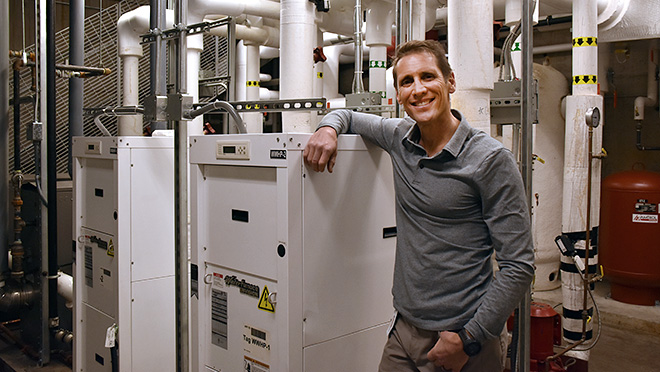Continuous Optimization program: boosting energy savings in B.C. schools

What is Continuous Optimization?
The Continuous Optimization program is a joint offer from BC Hydro and FortisBC, helping customers save energy and improve operations in large commercial buildings without a major capital investment. The program focuses on improving efficiency on energy-intensive systems, such as heating, ventilation and air conditioning (HVAC) with simple, low-cost solutions.
Continuous Optimization is particularly suitable for school districts, which generally have a range of HVAC systems, varying widely in age, type, and efficiency. We talked to a couple of energy managers in different parts of the Lower Mainland to find out how Continuous Optimization helps them keep on top of savings.
Richmond School District (SD 38)
Jonathan Ho is the manager of energy and sustainability with Richmond School District (SD 38) and he's very passionate about his work. "I've been working here for just over four years, but I also went to elementary, junior high and senior high here. My father taught here. My wife is a teacher librarian here. And my two kids go to school here. So I'm a lifer!"
An interest in improving the district's waste diversion statistics is what drew Jonathan back to SD 38. "The city diverts 80 percent of waste away from the landfill, but in the school district, we only divert about 35 percent. So I work on behaviour change pieces, along with overseeing rooftop units, building automation systems and energy consumption," he explains.
Right now, SD 38 is in the process of implementing a District Sustainability and Climate Action Plan. The deliverables are aligned with CleanBC's goals:
- A 50% reduction in greenhouse gas emissions by 2030,
- A 40% reduction in fleet emissions by 2030, and
- Achieving net zero operations by 2050.
Jonathan says the district has a strategic energy management plan that commits to annual improvements in its building energy use index, which is the equivalent kilowatt-hours per square metre of occupied area. "Right now, 90 percent of our building emissions are natural gas-fired boilers that heat hydronic systems. We've got annual electricity target reductions of 300,000 kilowatt-hours, and at least 75,000 kilowatt-hours of fossil fuel displacement – primarily driven right now by electrifying our fleet," he says.
Two of Richmond's 15 school buses are already electric, and there's combined funding from us, CleanBC and the Federal Ministry of Infrastructure available for three more. Lighting is also a big-ticket item in Richmond, and 90% of high schools have had LED lighting upgrades.
Jonathan likes to describe Continuous Optimization as low-hanging fruit that keeps growing back. "Every year, I work with our mechanical HVAC and electrical teams to identify 10 suitable schools. The teams really enjoy this program because it allows us to do a deep dive that we wouldn't otherwise have time for, ensuring that any end-of-life, low-efficiency boiler systems are replaced by high-efficiency ones."
Coquitlam School District (SD 43)
Coquitlam School District (SD 43) is the third largest in the Lower Mainland, after Surrey and Vancouver. Their energy manager, Adrian Pettyfer, is a big fan of the Continuous Optimization program.
"SD 43 has over 80 schools of varying ages and complexities. We're always looking at the different schools' energy consumption to identify which ones may have an opportunity to become more energy efficient through expensive capital upgrades or by simply recommissioning them to run as they were designed," says Adrian.
Coquitlam School District also follows the CleanBC program and has the same goals as Richmond. But it focuses on Continuous Optimization in a slightly different way: "We're finding that a lot of schools constructed over the last 10 years have these fantastic systems which were carefully designed by engineers when the school was built. But for various reasons, some of these systems fail and begin running incorrectly," reflects Adrian.
After these new buildings pass their one-year warranty period, they're often left to teams who aren't necessarily trained to maintain them. "The Continuous Optimization program is very valuable to us as it helps us to really look at our systems and understand how to make them work properly," Adrian explains.
Eagle Mountain Middle School in Anmore, just north of Port Moody, was Adrian's first foray into Continuous Optimization. "We were able to reprogram the whole building and found 400 gigajoules of gas savings in the first six months post-recommissioning by bringing the heat pumps that were already there back to life," he says.
For seven years before that, the school's heat pumps were inoperative due to programming issues, and backup boilers were used instead. "The Continuous Optimization program gave us the opportunity to have the system looked at by engineers who tuned the heating system back to the way it was meant to run. At the same time, our maintenance team received proper education on the system," Adrian says.
The school also added safety precautions to ensure the heat pumps never fail. "Since then, they've worked flawlessly," adds Adrian. "The Continuous Optimization program is an excellent double check for a newly built school."
What does the future look like?
In SD 38, Jonathan says the district will be looking at how it can support the increase in low-carbon electrification and electricity consumption. "We're exploring how we can move to air-source heat pumps without breaking the bank. We're also looking into how we can integrate solar photovoltaics into our building systems so that electrification doesn't lead to overspending on energy bills.
But the sustainability and energy manager emphasizes that the district needs to strike a balance between electricity and energy demand, and the structural upgrades needed to accommodate them.
Want to continue the conversation?
To find out more about Continuous Optimization, contact your Key Account Manager or Regional Energy Manager, or call 604 522 4713 in the Lower Mainland or 1 866 522 4713 elsewhere in B.C.